Being with elephants is definitely a mystical experience. Actually, being in the vastness of nature with all the plants and wildlife is the most soul-connecting-welcome-home experience I’ve ever had. Rounding a corner to find a mother elephant and junior grazing on the bushes next to the road is heart stopping. 
 Then out of nowhere, the huge male comes lumbering out of the bushes,
Then out of nowhere, the huge male comes lumbering out of the bushes, only to disappear in front of your eyes on the other side. You never know what’s just inside the bush beyond the first layer. The thrill of discovery is noticing the cork-screw horn of a kudu in the bushes long before you see the body.
only to disappear in front of your eyes on the other side. You never know what’s just inside the bush beyond the first layer. The thrill of discovery is noticing the cork-screw horn of a kudu in the bushes long before you see the body.
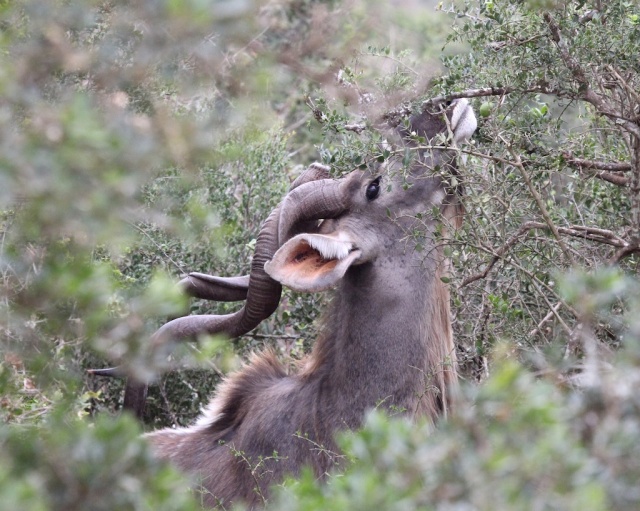
 It’s very difficult to put this experience into words, so mostly I’ll just post the photographs with only some comments to point out behaviors and dynamics that a still just can’t capture. The first morning of our game drive, we saw the elephants from a distance only,
It’s very difficult to put this experience into words, so mostly I’ll just post the photographs with only some comments to point out behaviors and dynamics that a still just can’t capture. The first morning of our game drive, we saw the elephants from a distance only, 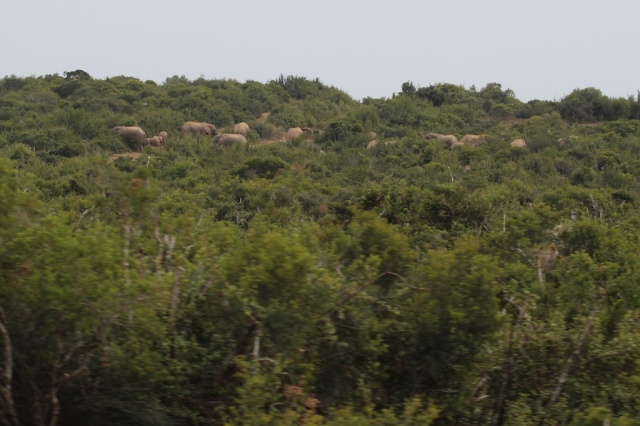 but with my lens, I could still enjoy some ‘close’ looks.
but with my lens, I could still enjoy some ‘close’ looks.  There were several babies in the first fairly large group of females and calves that we saw. From a beginning of Addo Elephant National Park in 1931 with only 11 elephants who survived the concerted effort to exterminate all elephants in this region, and introducing some bulls from the Kruger for more genetic diversity, there are now 600+ elephants in Addo, and they looked very healthy. The park covers a vast area of 1,640 km2 (630 sq mi) with abundant scrub for all the various animals,
There were several babies in the first fairly large group of females and calves that we saw. From a beginning of Addo Elephant National Park in 1931 with only 11 elephants who survived the concerted effort to exterminate all elephants in this region, and introducing some bulls from the Kruger for more genetic diversity, there are now 600+ elephants in Addo, and they looked very healthy. The park covers a vast area of 1,640 km2 (630 sq mi) with abundant scrub for all the various animals, and it’s managed well by rotating areas to preserve the food supply, as elephants can be quite destructive. Our first day was cold (I’m talking 4 C or 39 F), damp and overcast (and we weren’t dressed at all warmly enough; thank goodness for blankets),
and it’s managed well by rotating areas to preserve the food supply, as elephants can be quite destructive. Our first day was cold (I’m talking 4 C or 39 F), damp and overcast (and we weren’t dressed at all warmly enough; thank goodness for blankets), and the light for photographing was just ‘ok.’ We had a great guide, David, with Crisscross Adventures, (the middle two are Menno and Jorike from Holland)
and the light for photographing was just ‘ok.’ We had a great guide, David, with Crisscross Adventures, (the middle two are Menno and Jorike from Holland)
 offered by Chrislin African Lodge outside of Addo Park
offered by Chrislin African Lodge outside of Addo Park 

 where we stayed in a mud hut (ours is on the right).
where we stayed in a mud hut (ours is on the right).

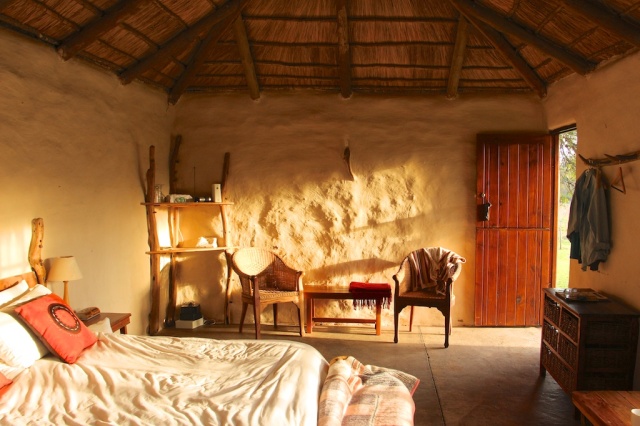 View from our window in the am.
View from our window in the am. Can you image riding in an open Land Rover on the main country road at 45-50 mph in shirt sleeves (Michael) and a light sweat shirt jacket (me)? I could hardly hold my camera when we got to Addo. Lesson learned. Anyway, David was very knowledgeable and passionate about educating us about the animals he loves. This showed up particularly when we drove past an adder which had been run over.
Can you image riding in an open Land Rover on the main country road at 45-50 mph in shirt sleeves (Michael) and a light sweat shirt jacket (me)? I could hardly hold my camera when we got to Addo. Lesson learned. Anyway, David was very knowledgeable and passionate about educating us about the animals he loves. This showed up particularly when we drove past an adder which had been run over.  He was quite disgusted and upset that anyone would do that within the park and notified the rangers. It was unconscionable to him that someone would kill an animal in the park. Elephants, kudus, Burchell’s zebras, jackals, warthogs and various birds, which I’ll name individually later, were the main wildlife we saw on Tuesday. Besides encountering the animals themselves, the thrill of a game drive in an open Land Rover is the ‘discovery’ or ‘sightings,’ actually spotting the animals in the bush, perhaps even up close.
He was quite disgusted and upset that anyone would do that within the park and notified the rangers. It was unconscionable to him that someone would kill an animal in the park. Elephants, kudus, Burchell’s zebras, jackals, warthogs and various birds, which I’ll name individually later, were the main wildlife we saw on Tuesday. Besides encountering the animals themselves, the thrill of a game drive in an open Land Rover is the ‘discovery’ or ‘sightings,’ actually spotting the animals in the bush, perhaps even up close. As I said, you just never know when elephants will come out of the bush to cross the road or be feeding next to the road around a blind corner.
As I said, you just never know when elephants will come out of the bush to cross the road or be feeding next to the road around a blind corner.
 You drive slowly! The kudu, called ‘ghost spirits’, by the locals here, are magical, because they suddenly appear and just as suddenly disappear – now you see them; now you don’t. Exquisite animals they are!
You drive slowly! The kudu, called ‘ghost spirits’, by the locals here, are magical, because they suddenly appear and just as suddenly disappear – now you see them; now you don’t. Exquisite animals they are! 
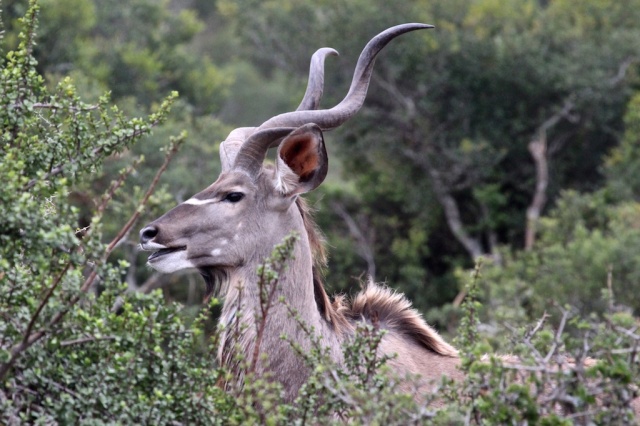 These young Nyala females below were spotted outside the park on our way up the Zuurberg Mountain Village. Notice the short horns in the juvenile in the second picture.
These young Nyala females below were spotted outside the park on our way up the Zuurberg Mountain Village. Notice the short horns in the juvenile in the second picture.
 Watching elephants at a distance is ok, but up close is much better. The first day, we saw close up only a solitary male or two at one or two different watering holes,
Watching elephants at a distance is ok, but up close is much better. The first day, we saw close up only a solitary male or two at one or two different watering holes, or small groups of females and their calves just leaving.
or small groups of females and their calves just leaving. The second day was a completely different experience. The skies were clear; it was warmer and dryer (better for photography), and we were in our own car, at our own pace. It was fantastic! We watched elephants up close for over an hour
The second day was a completely different experience. The skies were clear; it was warmer and dryer (better for photography), and we were in our own car, at our own pace. It was fantastic! We watched elephants up close for over an hour

 and a solitary old bull who took a mud bath at the watering hole.
and a solitary old bull who took a mud bath at the watering hole. 
 He had to make sure he got is facial mud pack also and then rub it off his horns. A yellow mongoose is visible crossing in back of the buffalo only on the video I took (but it still counts as a siting!). Then a Black-backed jackal showed up to drink
He had to make sure he got is facial mud pack also and then rub it off his horns. A yellow mongoose is visible crossing in back of the buffalo only on the video I took (but it still counts as a siting!). Then a Black-backed jackal showed up to drink
 and a young female whom the bull would not allow close to his herd.
and a young female whom the bull would not allow close to his herd. Then more thirsty elephants came running down the hill for their turn to at the waterhole.
Then more thirsty elephants came running down the hill for their turn to at the waterhole.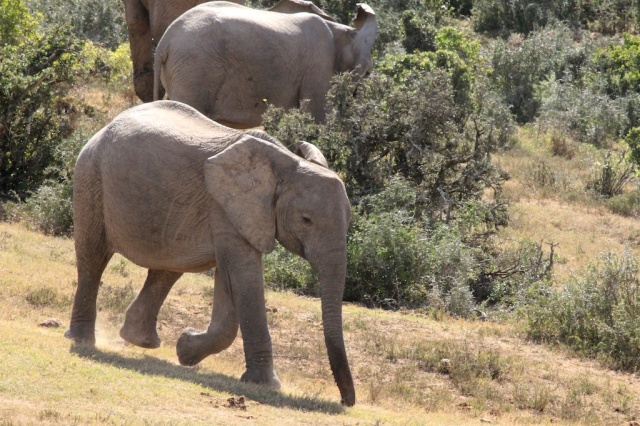 Later, we saw a huge herd of about 50 buffalo just leaving an area as we arrived.
Later, we saw a huge herd of about 50 buffalo just leaving an area as we arrived. But when one event is over, another begins. Warthogs were everywhere, and very curious,
But when one event is over, another begins. Warthogs were everywhere, and very curious,
 and more zebras
and more zebras One way to anticipate the elephants in an area is fresh dung on the road, and with this, you can expect the endangered Flightless dung beetle (wings have fused together).
One way to anticipate the elephants in an area is fresh dung on the road, and with this, you can expect the endangered Flightless dung beetle (wings have fused together). 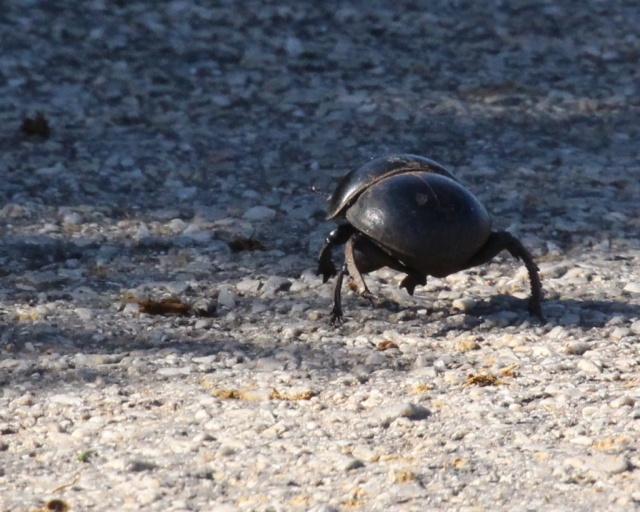
 There are numerous warnings in the Park not to drive over the dung because of these beetles and their endangered status. In addition to the baby elephants, we spotted a baby zebra.
There are numerous warnings in the Park not to drive over the dung because of these beetles and their endangered status. In addition to the baby elephants, we spotted a baby zebra.
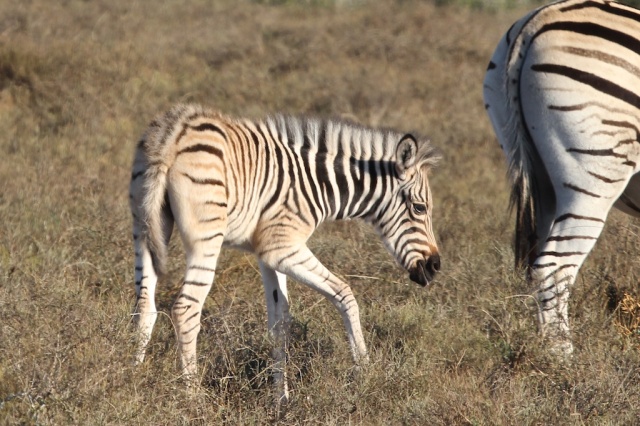


 Termite mounds
Termite mounds Webs built by moths
Webs built by moths 
 A Leopard tortoise just at the side of the road
A Leopard tortoise just at the side of the road One great joy at the watering hole where we spent so much time watching and photographing elephants, the old buffalo, a yellow mongoose and the jackal (this sounds like an African tale) was meeting Joan Young,
One great joy at the watering hole where we spent so much time watching and photographing elephants, the old buffalo, a yellow mongoose and the jackal (this sounds like an African tale) was meeting Joan Young, the photographer, ecologist, as we watched the buffalo come to the waterhole. What a special lady, living out of her car to travel, photograph and educate about the wonders of nature. Her blog: www.saphotographs.blogspot.com. She guides game drives (safaris) also, so if you ever want to visit Kruger or the many other parks here, she’s the one to contact. Of the Big Five (Elephants, Buffalo, Lions, Giraffes and Rhino), we only missed seeing the rhino. Next time. And then there are the birds we spotted in the Park: Bokmakierie.
the photographer, ecologist, as we watched the buffalo come to the waterhole. What a special lady, living out of her car to travel, photograph and educate about the wonders of nature. Her blog: www.saphotographs.blogspot.com. She guides game drives (safaris) also, so if you ever want to visit Kruger or the many other parks here, she’s the one to contact. Of the Big Five (Elephants, Buffalo, Lions, Giraffes and Rhino), we only missed seeing the rhino. Next time. And then there are the birds we spotted in the Park: Bokmakierie.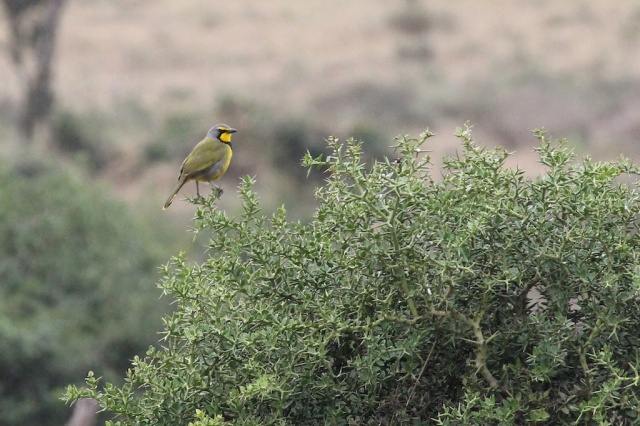 They sing the most beautiful duet.
They sing the most beautiful duet. Common Fiscal (shrike) were all over the park .
Common Fiscal (shrike) were all over the park .
 Grey Heron
Grey Heron Black headed Heron
Black headed Heron Cattle Egret
Cattle Egret Southern Chanting Goshawk
Southern Chanting Goshawk 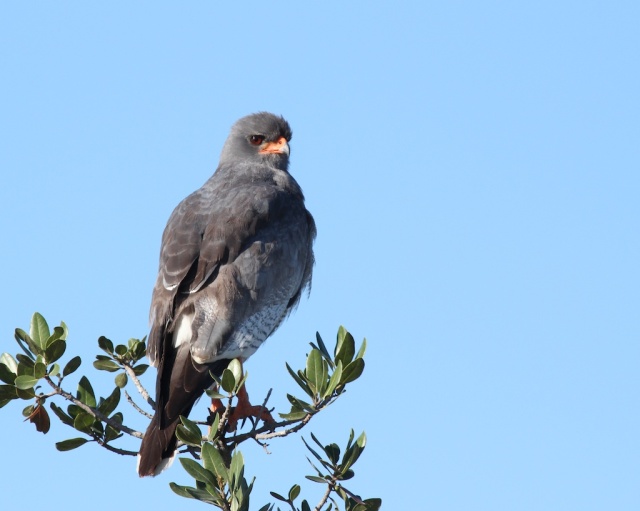 African Hoopoe
African Hoopoe
 Blacksmith Plover
Blacksmith Plover  Crowned lapwing
Crowned lapwing Speckled Mousebird
Speckled Mousebird Robin chat (Cape Robin)
Robin chat (Cape Robin)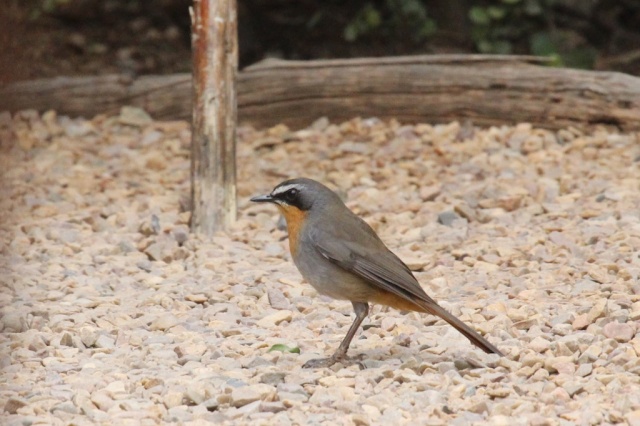 that fans its rufous tail feathers.
that fans its rufous tail feathers.  Cape Sparrow
Cape Sparrow Pied Crows on a mating flight
Pied Crows on a mating flight Masked Weaver
Masked Weaver and its basket woven amongst the thorns.
and its basket woven amongst the thorns. Fork-tailed Drongo
Fork-tailed Drongo Greater Doubled Collared Sunbird
Greater Doubled Collared Sunbird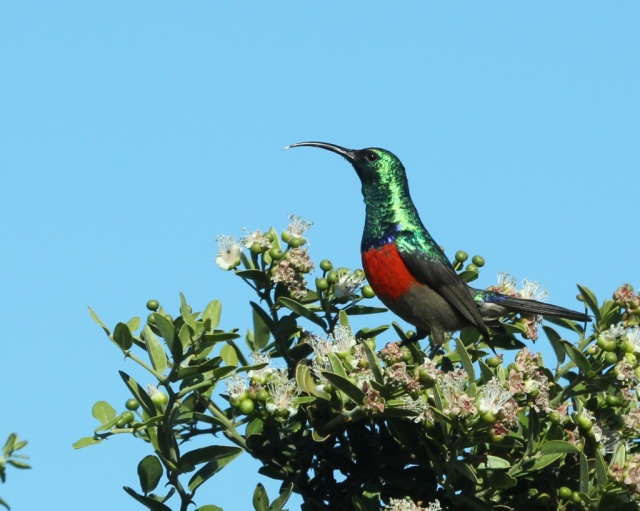
 On way back home to East London, we stopped in Alexandria as we had been told about the Quin Sculpture Garden. We were not disappointed. Now in her mid 80s and internationally renowned, Maureen Quin is a remarkable sculptor.
On way back home to East London, we stopped in Alexandria as we had been told about the Quin Sculpture Garden. We were not disappointed. Now in her mid 80s and internationally renowned, Maureen Quin is a remarkable sculptor. Her styles are varied and all exquisite.
Her styles are varied and all exquisite. 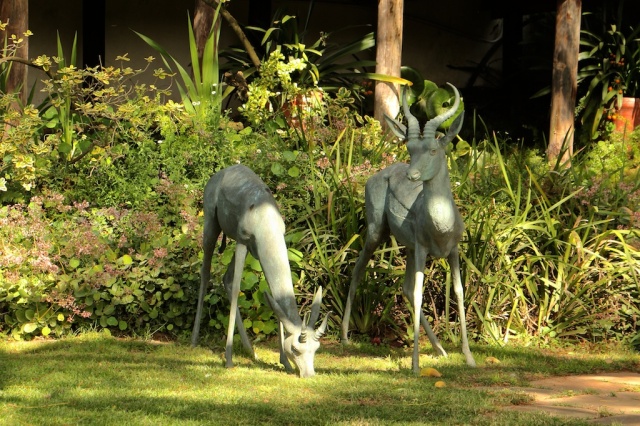

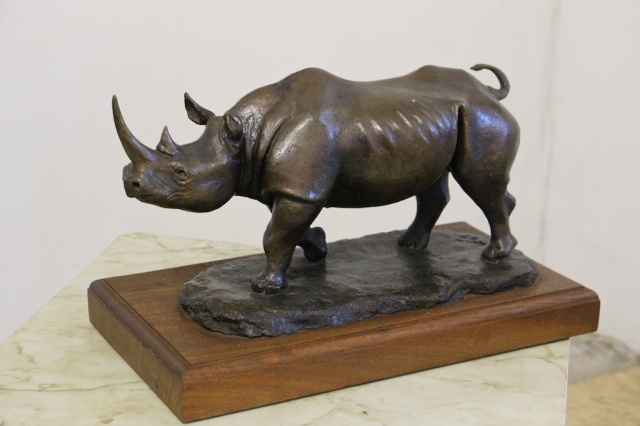


 I especially love her ability to capture facial expressions and moods.
I especially love her ability to capture facial expressions and moods. 


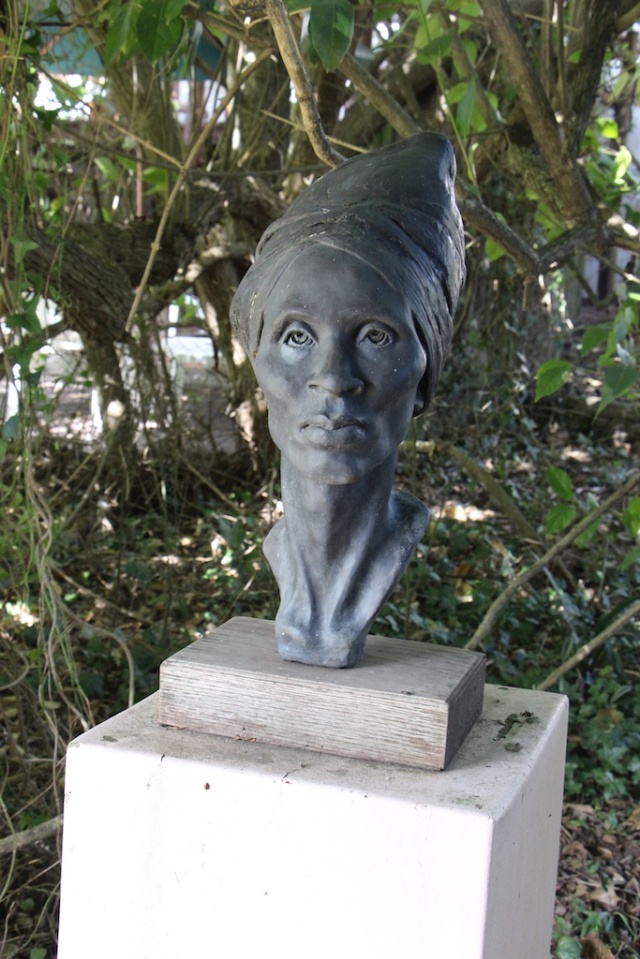

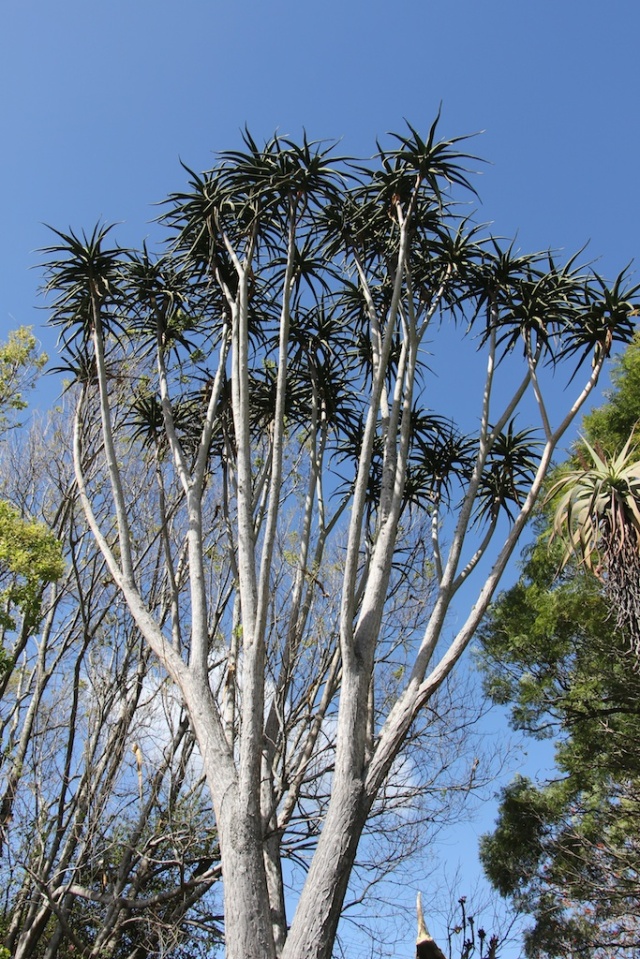 An amazing trip overall and fitting end to our South African exploration. Our appetite for this vast and amazing country has only just been whetted. We still have several places on our list for the future: Kruger Park, Lesotho, Soweto township, the Karoo, Cape Town…shall I go on?
An amazing trip overall and fitting end to our South African exploration. Our appetite for this vast and amazing country has only just been whetted. We still have several places on our list for the future: Kruger Park, Lesotho, Soweto township, the Karoo, Cape Town…shall I go on?
-
Recent Posts
- SA Trip – Aug 26-31,2014 September 9, 2014
- SA Trip – Aug 24, 2014 August 28, 2014
- SA Trip – Aug 16-24,2014 August 28, 2014
- SA Trip – Aug 11-15, 2014 August 15, 2014
- SA Trip – Aug 8-10, 2014 August 11, 2014
- SA Trip – Aug 6-7, 2014 August 7, 2014
- SA Trip – Aug 2-5, 2014 August 6, 2014
- SA Trip – Aug 1, 2014 August 4, 2014
- SA Trip – July 29-30, 2014 August 3, 2014
- SA Trip – July 24 – 28, 2014 July 28, 2014
- SA Trip, July 19-23, 2014 July 23, 2014
- SA Trip – July 17, 18, 2014 July 19, 2014
- SA Trip – July 12-16, 2014 July 16, 2014
- SA Trip – July 10-11, 2014 July 12, 2014
- SA Trip – July 7-9, 2014 July 10, 2014
- SA Trip – July 6, 2014 July 7, 2014
- South Africa Trip – July 4-5, 2014 July 7, 2014
- South Africa Trip – July 3, 2014 July 4, 2014
- South Africa Trip – July 2, 2014 July 4, 2014
- South Africa Trip – July 1, 2014 July 4, 2014
- South Africa Trip – June 21-30, 2014 July 4, 2014
- South Africa Trip – June 13-20, 2014 July 4, 2014
Recent Comments
pluciaphoto on SA Trip – Aug 8-10,… pluciaphoto on SA Trip – Aug 11-15,… pluciaphoto on SA Trip – Aug 16-24… pluciaphoto on SA Trip – July 6, 2… Joan Young on SA Trip – Aug 26-31… -
Join 9 other subscribers






Thanks for sharing your photos and stories, wonderful! Hope to see you soon.
LikeLike
Great photos–love the corkscrew horn through the bushes!
LikeLike